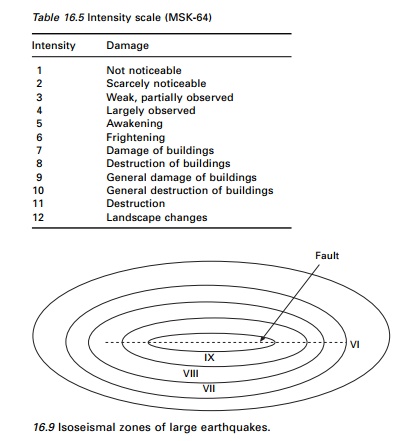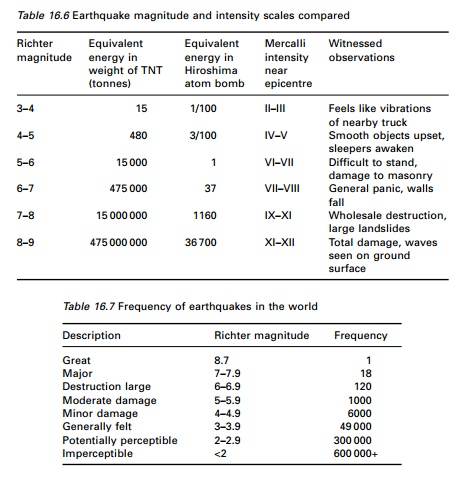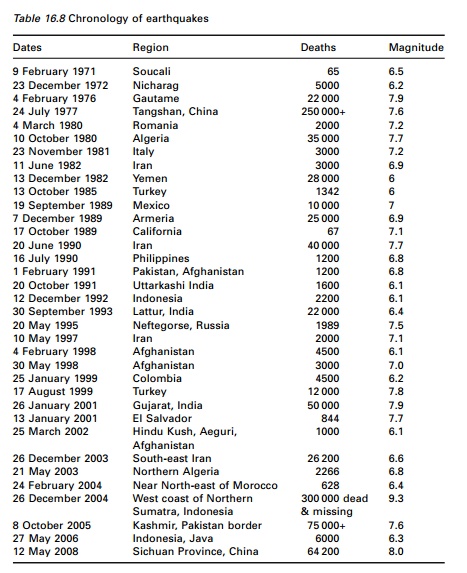Chapter: Civil : Structural dynamics of earthquake engineering
Earthquake intensity and magnitude
Earthquake
intensity and magnitude
1 Intensity
The oldest useful
yardstick of the strength of an earthquake is the earthquake intensity.
The intensity of an earthquake is used to determine its severity at a
particular location as determined by human reactions to EarthŌĆÖs movement,
observed damage to structures, and observation of other physical effects.
Because earthquake intensity assessments do not depend on instruments, but on
the actual observation of effects in the seismal zone, intensities can be
assigned to historical earthquakes. In this way the historical record becomes
of utmost importance in modern estimates of seismological risk. Thus the
intensity will vary with distance from the causative fault and with local
ground conditions. Intensity is a qualitative measure of the actual
shaking at a location during an earthquake, and assigned as Roman capital
numerals.
The first intensity
scale was developed by de Rossi of Italy and Forel of Switzerland in the 1880s.
This scale, with values I to X, was used for reports of the intensity of the
1906 San Francisco earthquakes, for example. A new refined scale was devised by
the Italian volcanologist and seismologist Mercalli in 1902 with a 12-degree
range from I to XII. More refined scales were developed by Cancanio. In 1931
Frank Neumann and H O Wood proposed a 12 grade modified Mircalli (MMI) scale,
which has been widely adopted in South America, and other parts of the world.
Other intensity scales in use today are the 12-grade Medvedev ŌĆ' Sponheuer
Karnik (MSK-64) scale and the 8-grade Japanese Meteorological Agency (JMA)
scale. Because intensity scales are subjective and highly dependent on the construction
practices and socio-economic conditions of a country, and bear no specific
relation to the ground motion, correlation among the various intensity scales
is not easily done. Both the MMI and the MSK scales are quite similar and range
from I (least perceptive) to XII (most severe). The intensity scales are based
on three features of shaking:
ŌĆó
perception by people and animals;
ŌĆó
performance of buildings;
changes to natural surroundings.
IS1893 (Part 1): 2002
adopts a comprehensive intensity scale (MSK-64) and this is given in Table 16.5
for completeness.
The intensity of the
earthquake is greatest in the vicinity of the causative fault and decreases
with distance from the fault. Curves of equal intensity as shown in Fig. 16.9
called ŌĆśisoseismalsŌĆÖ assume a bell-shaped pattern for small earthquakes.
For large earthquakes having a slipped length of fault of several hundred
kilometres, the idealized isoseismals become quite elongated in a direction
parallel to causative fault. In actuality, however, the isoseismals are more
complex as they are influenced by such factors as local site and geological
conditions.
2 Earthquake magnitude
If sizes of earthquakes are to be compared
worldwide, a measure is needed that does not depend, as does intensity, on the
density of population and type of construction. A strictly quantitative scale
that can be applied to earthquakes

in both inhabited and
uninhabited regions was originated by Wadati in 1931 in Japan and developed by
Charles Richter in 1935 in California.
Richter defined the magnitude
of a local earthquake as the logarithm to base ten of the maximum seismic wave
amplitude in micrometres (10ŌĆ'4 cm) recorded on a Wood Anderson
seismograph located at a distance of 100 km from the earthquake epicentre. This
means that a ten-fold increase in the amplitude of the earthquake waves results
in the magnitude of the scale going up by one unit.
Since the fundamental
period of a seismograph is 0.8 s, it selectively amplifies those seismic
waves with a period ranging from 0.5 to 1.5 s because the natural period of
many buildings is within this range. The local Richter magnitude remains the
value familiar to engineers. Richter also found that among earthquakes
occurring at the same distance, larger earthquakes have bigger wave amplitude
than smaller earthquakes and also greater distances have lower amplitude than
at shorter distances. This is obtained from the seismogram and accounts for the
dependence of wave-form amplitude and epicentral distance. This scale is
called Richter scale or local magnitude scale.
The magnitude of the earthquake is determined from
the expression:
M = log10
A ---- --- - 16.4
where A is the maximum seismic amplitude in
(10ŌĆ'4 m). However, a standard seismograph is not always set at a
distance of 100 km from the epicentre, in which case it can be modified as
M = log10
A ŌĆ' log10 A0 --- -- - - 16.5
where A is the maximum seismic wave amplitude
for the measured earthquake at a given epicentre distance and A0
is the seismographic reading produced by standard earthquake (A0
= 0.001). A correlation between the amount of energy Ef
released at the causative fault and the Richter magnitude was developed by
Gutenberg and Richter and is expressed as
log10 Ef = 4.8 + 1.5M --- --- 16.6
Because the Richter
magnitude is a logarithmic scale, an increase of unity in magnitude represents
10-fold increase in the amplitude of the seismic waves (e.g., a reading of 7
represents 10 times greater amplitude than a reading of 6).
For instance, energy release for earthquakes of
values 6 and 7.

So the energy released
in an M7 earthquake is about 31 times that released in an M6 and
in an M8 the energy released is about 1000 (31 ’ā- 31) times that released
in an M6 earthquake. Most of the energy released goes into heat and
fracturing rocks and only a small fraction of it (fortunately) goes into the
seismic waves that travel a larger distance, causing shaking of the ground en
route and hence damage to structures. The energy releases for various
magnitudes of earthquake and the corresponding intensity scales are compared in
Table 16.6.
An empirical relation between Richter magnitude M,
modified Mercalli intensity (MM) and focal distance ŌĆśdŌĆÖ in km was
suggested by Esteva and Rosenblueth as
MM = 8.16 + 1.45 MŌĆ'2.46 ln (d) --- --- 16.10
It is interesting to
note that energy released in an M6.3 earthquake is equivalent to that
released by the 1945 atom bomb dropped on Hiroshima.
Earthquakes having M
< 5 generate ground motions unlikely to cause damage because of their very
short duration and moderate acceleration. An earthquake with a magnitude of 7.2
would be considered a strong earthquake. Earthquakes with magnitudes above 7.5
are referred to as great earthquakes, whereas earthquakes with magnitude < 2
or less are known as micro-earthquakes. Table 16.7 shows the frequency of
occurrence of various types of earthquakes. There are one million earthquakes
annually, 80 000/month;
2600/day; 2/minute; 1
earthquake is felt every 30 s. The frequency of earthquake for any magnitude
>M is given by N = 106.7ŌĆ'0.9M.
At its inception, the idea behind the Richter-local
magnitude scale (ML) was a modest one, applicable to shallow earthquakes and
epicentre distance

< 600 km. Today the
method has been extended to a number of types of seismographs throughout the
world. Consequently there are a variety of magnitude scales on different
formulae for epicentre distance and the ways of choosing appropriate wave
amplitude.
3 Surface wave magnitude (Ms)
Periods of 20 s are
usually dominant on seismograph records of distant earthquakes (epicentral
distance > 2000 km). Gutenberg defined a magnitude scale based on measuring
the amplitude of surface waves within a period of 20 s.
4 Body wave magnitude (Mb)
Deep focus earthquakes
have only small or insignificant trains of surface waves. It is customary to
measure the velocity of the P wave, which is not affected by focal depth of the
source.
5 Moment magnitude (Mw)
The best estimates of an earthquakeŌĆÖs magnitude,
especially for great earthquakes, are given by the moment magnitude (Mw).
This scale emulates the magnitude of an earthquake in terms of seismic
movement, M0, that is directly related to the amount of
energy released in the earthquake. Mw is expressed as
Mw =
log10 (M0/1.5) ŌĆ' 10.7 ----16.11
where M0 = ╬╝ AsD, ╬╝ = parameter characterizing the rigidity of the material surrounding the causative fault, As = slipping area and D = distance of slip.
In the light of the above discussions, an
application of different scales has been suggested for measuring shallow
earthquakes of various magnitudes.
MD for
magnitudes < 3 --- --- 16.12
ML or
Mb 3< M < 7 --- --- 16.13
Ms 5
< M < 7.5 --- --- 16.14
Mw for
all magnitudes --- --- 16.15
Table 16.8 shows some of the major earthquakes in
the world 1971ŌĆ'2008. Out of various earthquakes occurring in the world, the
circum-pacific seismic zone is the principal zone which accounts for 80% of all
earthquakes

and most tectonic
activity. At some places chains of volcanoes cause a ŌĆścircle of fireŌĆÖ; Alpide
zone accounts for 15% of earthquakes and the remaining are in the narrow zone
of Atlantic and Indian Ocean.
Related Topics